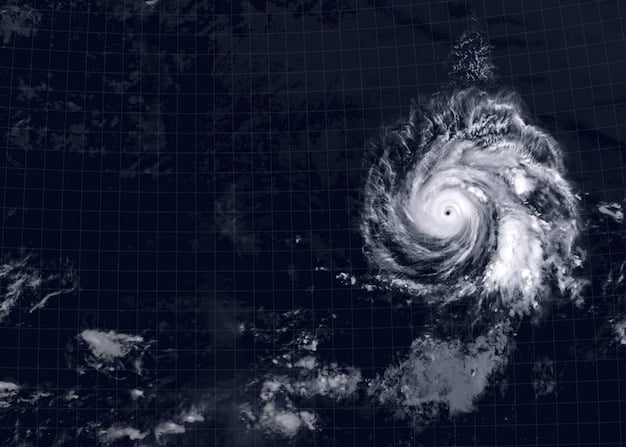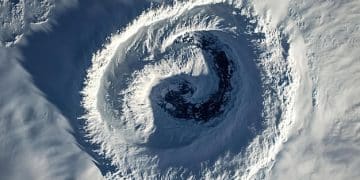The Future of Weather: New Forecasting Technologies & Accuracy

New weather forecasting technologies are revolutionizing our ability to predict weather patterns with greater accuracy and provide earlier warnings, leveraging advancements like AI, satellite technology, and enhanced data analytics.
Advancements in new weather forecasting technologies are rapidly changing how we predict and prepare for weather events, offering unprecedented accuracy and lead times.
Advancements in Weather Modeling
Weather modeling has undergone a significant transformation, driven by the need for more accurate and reliable forecasts. The integration of advanced computational techniques and extensive data sets has led to substantial improvements in predictive capabilities.
The Role of High-Resolution Models
High-resolution models play a crucial role in modern weather forecasting. These models provide a detailed representation of the Earth’s atmosphere, enabling forecasters to capture small-scale weather phenomena with greater precision.
Ensemble Forecasting Techniques
Ensemble forecasting involves running multiple simulations of a weather model with slightly different initial conditions. This approach allows forecasters to assess the range of possible outcomes and quantify the uncertainty in their predictions.
- Improved accuracy in predicting severe weather events.
- Better assessment of the likelihood of different weather scenarios.
- Enhanced ability to communicate uncertainty to the public.
By leveraging high-resolution models and ensemble forecasting, meteorologists can provide more reliable and informative weather forecasts, contributing to improved decision-making across various sectors.

Artificial Intelligence in Weather Prediction
Artificial intelligence (AI) is revolutionizing weather prediction by providing powerful tools for data analysis, pattern recognition, and model refinement. Machine learning algorithms can process vast amounts of weather data to identify intricate relationships and improve forecast accuracy.
Machine Learning Algorithms
Machine learning algorithms, such as neural networks and decision trees, are capable of learning from historical weather data to identify patterns and predict future weather conditions. These algorithms can be trained to recognize complex relationships that may be difficult for traditional forecasting methods to capture.
Data Assimilation Techniques
Data assimilation is the process of integrating observational data into weather models to improve their accuracy. AI-powered data assimilation techniques can automatically identify and correct errors in observational data, leading to more reliable model predictions.
AI is transforming weather forecasting by enhancing both the accuracy and efficiency of weather models. As AI technology continues to advance, its role in weather prediction is expected to grow, leading to even more reliable and timely weather information.
Satellite Technology and Remote Sensing
Satellite technology and remote sensing provide critical data for weather forecasting, offering a comprehensive view of the Earth’s atmosphere and surface conditions. Satellites equipped with advanced sensors can measure temperature, humidity, wind speed, and other key weather variables, providing essential information for weather models.
Geostationary and Polar-Orbiting Satellites
Geostationary satellites remain fixed over a specific location on Earth, providing continuous monitoring of weather conditions in that region. Polar-orbiting satellites, on the other hand, orbit the Earth from pole to pole, providing global coverage and capturing images of the entire planet.
Advanced Sensor Technology
Advanced sensor technology, such as hyperspectral imagers and microwave sounders, enables satellites to measure a wide range of atmospheric variables with high precision. These sensors provide valuable data for weather models, leading to more accurate forecasts.
- Improved monitoring of severe weather events.
- Enhanced detection of atmospheric pollutants.
- Better understanding of climate change impacts.
Satellite technology and remote sensing are essential tools for modern weather forecasting, providing critical data for weather models and enabling forecasters to monitor weather conditions around the globe.

The Internet of Things (IoT) and Weather Monitoring
The Internet of Things (IoT) is transforming weather monitoring by creating a network of interconnected devices that collect and share weather data. IoT devices, such as weather stations, sensors, and smart devices, provide a wealth of real-time weather information that can be used to improve forecast accuracy.
Smart Weather Stations
Smart weather stations are equipped with sensors that measure temperature, humidity, wind speed, rainfall, and other weather variables. These stations can transmit data wirelessly to a central database, providing a comprehensive view of weather conditions in a specific area.
Mobile and Wearable Sensors
Mobile and wearable sensors, such as smartphones and smartwatches, can also contribute to weather monitoring. These devices are equipped with sensors that measure temperature, humidity, and air pressure, providing valuable data for weather models.
The IoT is enhancing weather monitoring by providing a network of interconnected devices that collect and share weather data. This real-time information can be used to improve forecast accuracy and provide more timely weather warnings to the public.
Big Data Analytics and Weather Forecasting
Big data analytics is playing an increasingly important role in weather forecasting, enabling forecasters to process and analyze vast amounts of weather data more efficiently. By applying advanced analytical techniques, meteorologists can identify patterns, trends, and anomalies in weather data, improving the accuracy of their predictions.
Data Storage and Processing
Effective data storage and processing are essential for big data analytics in weather forecasting. Cloud-based storage solutions and high-performance computing clusters provide the necessary infrastructure for storing and processing large volumes of weather data.
Data Mining Techniques
Data mining techniques, such as clustering and classification, can be used to identify patterns and relationships in weather data. These techniques can help forecasters to better understand the underlying processes that drive weather phenomena.
Big data analytics is transforming weather forecasting by enabling forecasters to process and analyze vast amounts of weather data more efficiently. By applying advanced analytical techniques, meteorologists can improve the accuracy of their predictions and provide more timely weather warnings to the public.
Challenges and Future Directions
While new weather forecasting technologies have made significant strides, several challenges remain to be addressed. Improving the accuracy of long-range forecasts, enhancing the prediction of extreme weather events, and reducing the uncertainty in weather models are key priorities for future research and development.
Addressing Uncertainty in Weather Models
Uncertainty is an inherent characteristic of weather forecasting, stemming from the chaotic nature of the atmosphere. Developing methods to better quantify and communicate uncertainty is crucial for providing decision-makers with the information they need to make informed choices.
Global Collaboration and Data Sharing
Global collaboration and data sharing are essential for advancing weather forecasting capabilities. By sharing data, models, and expertise, countries can work together to improve weather prediction and provide more accurate and timely information to the public.
Addressing these challenges and pursuing future directions will lead to continued advancements in weather forecasting, resulting in more accurate and reliable weather information for decision-makers and the public.
| Key Point | Brief Description |
|---|---|
| 🛰️ Satellite Tech | Provides crucial atmospheric and surface data. |
| 🤖 AI Integration | Enhances data analysis and pattern recognition. |
| 🌐 IoT Networks | Real-time data from interconnected weather devices. |
| 📊 Big Data | Improves efficiency in processing and analyzing data. |
FAQ
▼
Satellites equipped with advanced sensors provide essential data on temperature, humidity, and wind speed, giving a comprehensive view of the Earth’s atmosphere for more accurate predictions.
▼
AI processes vast amounts of data to identify complex patterns and improve weather model accuracy, helping forecasters make more reliable predictions.
▼
The IoT creates a network of interconnected devices that collect and share real-time weather data, leading to improved forecast accuracy and quicker warnings.
▼
Ensemble forecasting involves running multiple simulations with slightly different initial conditions, providing a range of possible outcomes and improving risk assessment.
▼
Challenges include improving long-range forecast accuracy, predicting extreme weather events, and reducing uncertainty in models, which require ongoing research and collaboration.
Conclusion
In conclusion, new weather forecasting technologies are transforming our ability to predict and prepare for weather events. From AI and satellite technology to IoT and big data analytics, these advancements are improving forecast accuracy, extending lead times, and helping us make better decisions in the face of a changing climate.





